 |
By Walter Sorochan [Independent researcher]
Posted March 22, 2014; Updated November 10, 2021. Disclaimer The information provided below is intended for educational purposes only. It is not meant to either directly or indirectly give medical advice or prescribe treatment.
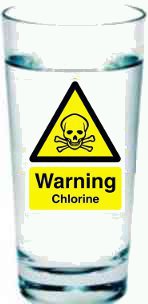 Most of us use chlorinated water in our homes. We drink it, shower in it, and use it in swimming pools. Why? Because local water treatment systems use chlorine to kill germs in the water. But while preventing water-borne diseases, 'clean' tap water also can cause more adverse health effects like: itchy skin, asthma, immune disorders, cancer, birth defects and so on. Chlorine is like a time bomb slowly hatching health problems! Ofcourse, most of these health problems have been ignored or misinterpreted by medical doctors and public water treatment systems while we continue to use chlorine in our out-dated 1909 water treatment systems.
Most of us use chlorinated water in our homes. We drink it, shower in it, and use it in swimming pools. Why? Because local water treatment systems use chlorine to kill germs in the water. But while preventing water-borne diseases, 'clean' tap water also can cause more adverse health effects like: itchy skin, asthma, immune disorders, cancer, birth defects and so on. Chlorine is like a time bomb slowly hatching health problems! Ofcourse, most of these health problems have been ignored or misinterpreted by medical doctors and public water treatment systems while we continue to use chlorine in our out-dated 1909 water treatment systems.
So since we are temporarily stuck with chlorine in our water, we need to become better informed and learn how to deal with it. This is what this article is about!
The experts say that chlorination is safe because chlorine is used in very small doses that kill germs but does not harm human bodies. But what they do not tell you is that the same dosage that kills pathogens can also affect your individual microscopic cells. Skin cells instantly absorb the chlorine. The affect on somatic cells is the link to chlorine that epidemiologists are talking about!
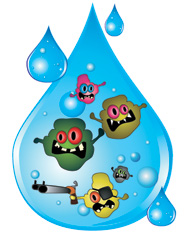 Chlorine is used to combat microbial contamination, but it can react with organic matter in the water and forms dangerous, carcinogenic Trihalomethanes and other disinfection byproducts. There is interest in using chloramines instead of chlorine because chloramines form very few disinfection by-products. Also, chloramines are more stable than chlorine and provide a longer bacteria kill time process. 1 2 But chlorine as a health issue persists.
Chlorine is used to combat microbial contamination, but it can react with organic matter in the water and forms dangerous, carcinogenic Trihalomethanes and other disinfection byproducts. There is interest in using chloramines instead of chlorine because chloramines form very few disinfection by-products. Also, chloramines are more stable than chlorine and provide a longer bacteria kill time process. 1 2 But chlorine as a health issue persists.
"The President's Council on Environmental Quality states that "there is increased evidence for an association between rectal, colon and bladder cancer and the consumption of chlorinated drinking water."
Video demonstrating chlorine absorption into skin
Source: Chlorine consultant
Health Links: Adding chlorine to water is bad for humans because chlorine is a toxic poison. Over time, daily exposure to chlorine can cause numerous illnesses and disorders. Research links chlorine [ and chloramines ]to the following health problems:
- autoimmune disorders 3 4 5
- itchy, dry skin 3 4 6 7
- causes our skin to age prematurely 4
- acne 5
- psoriasis & other skin disorders 5
- damages hair 3
- hair loss on the head
- causes numerous cancers 4 8 9
This may be an impressive list, but many links are weak and may be circumstantial in many instances. Although we need more confirmative research, we do have an incriminating alert that using chlorine is dangerous to our health! Israel stopped fluoridation in 2013, 25 while many countries in Europe are using oxidation in place of chlorine.
What happens to chlorine in the body?
There is a lot about chlorine that we do not know. But what we do know is what others have observed and felt! Here is a sample of what we know:
 When chlorine enters the body as a result of breathing, swallowing, or skin contact; it is very unstable and reacts with water to produce acids and disinfection byproducts. These byproducts damage cells in the body on contact in various ways.
When chlorine enters the body as a result of breathing, swallowing, or skin contact; it is very unstable and reacts with water to produce acids and disinfection byproducts. These byproducts damage cells in the body on contact in various ways.
" In water, chlorine reacts with sweat, urine, skin cells and other organic materials to produce all sorts of chemical byproducts. In animal studies, some of those chemicals have been linked with asthma and bladder cancer." 10
 Chlorine oxidizes lipid contaminants in the water. It thus creates free radicals, [highly reactive atomic or sub-atomic particles lacking an electron] and oxysterols [formed when lipid and oxygen molecules combine]. 4
Chlorine oxidizes lipid contaminants in the water. It thus creates free radicals, [highly reactive atomic or sub-atomic particles lacking an electron] and oxysterols [formed when lipid and oxygen molecules combine]. 4
 "Excess free radicals and excess oxysterols damage arteries and initiate cancer, among many other kinds of harm." 4
"Excess free radicals and excess oxysterols damage arteries and initiate cancer, among many other kinds of harm." 4
 Chlorine in water adversely affects beneficial intestinal flora; it destroys protective acidophilus, which nourishes and cooperates with the 3 to 3.5 pounds of immunity-strengthening “friendly” organisms lining the colon, where about 60 - 70 percent of our immune cells operate. And chlorine combines with organic impurities in the water to make trihalomethanes (THMs), or chloramines. 4 The compounds in disinfected water may be able to reach the gut not only through our drinking water, but also through daily showers and baths. 5 Chlorine disrupts the immune system!
Chlorine in water adversely affects beneficial intestinal flora; it destroys protective acidophilus, which nourishes and cooperates with the 3 to 3.5 pounds of immunity-strengthening “friendly” organisms lining the colon, where about 60 - 70 percent of our immune cells operate. And chlorine combines with organic impurities in the water to make trihalomethanes (THMs), or chloramines. 4 The compounds in disinfected water may be able to reach the gut not only through our drinking water, but also through daily showers and baths. 5 Chlorine disrupts the immune system!
 Chlorinated water alters and destroys unsaturated essential fatty acids (EFAs), the building blocks of human brains and central nervous systems. The compound hypochlorite, created when chlorine mixes with water, generates excess free radicals; these oxidize EFAs, turning them rancid. 4 The long-term impact of chlorine on the brain can cause many brain related disorders.
Chlorinated water alters and destroys unsaturated essential fatty acids (EFAs), the building blocks of human brains and central nervous systems. The compound hypochlorite, created when chlorine mixes with water, generates excess free radicals; these oxidize EFAs, turning them rancid. 4 The long-term impact of chlorine on the brain can cause many brain related disorders.
 Chloramine vapors are associated with greater risk of asthma, and may damage the mucosal lining of the respiratory tract. 5
Chloramine vapors are associated with greater risk of asthma, and may damage the mucosal lining of the respiratory tract. 5
 30% of all body toxins are excreted through the largest organ of our body–the skin; chlorine by-products cause dry itchy skin.
30% of all body toxins are excreted through the largest organ of our body–the skin; chlorine by-products cause dry itchy skin.
 Hair:
Hair: 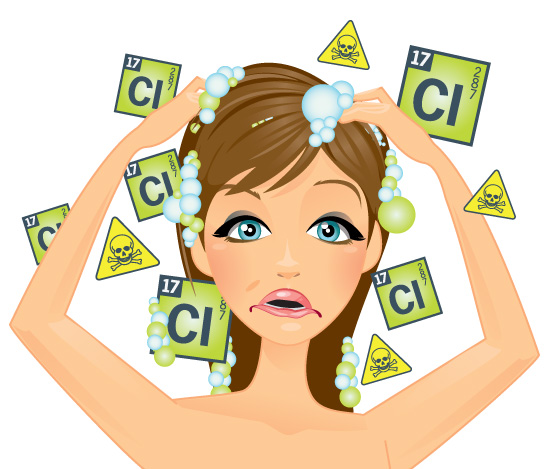
 Chlorine has the ability to burn the tips of your hair off, resulting in a strand of hair having a blunt end. When the hair grows back an illusion of thicker and darker hair is given. Furthermore, hair loss on the head can be significant. The hair, if exposed on a regular basis, will dry out, resulting in an increase in split ended hair strands and bleached ends. Chlorination disrupts the complex electronic structure responsible for color and it can break down the proteins in hair, essentially chopping them into smaller pieces that fall apart. It makes the hair brittle. Permed hair will relax. If the curl is natural, then no appreciable damage is evident. It can cause frizzy damaged hair.
Chlorine has the ability to burn the tips of your hair off, resulting in a strand of hair having a blunt end. When the hair grows back an illusion of thicker and darker hair is given. Furthermore, hair loss on the head can be significant. The hair, if exposed on a regular basis, will dry out, resulting in an increase in split ended hair strands and bleached ends. Chlorination disrupts the complex electronic structure responsible for color and it can break down the proteins in hair, essentially chopping them into smaller pieces that fall apart. It makes the hair brittle. Permed hair will relax. If the curl is natural, then no appreciable damage is evident. It can cause frizzy damaged hair.
 While the four THMs (chloroform, bromodichloromethane, dibromochloromethane and bromoform) can be measured in exhaled air, only chloroform is usually detected in blood. Chloroform and bromodichloromethane are the only THMs detected in urine. It is estimated that ingestion is the major route of exposure (94%), followed by inhalation (5%) and dermal contribution (1%).
While the four THMs (chloroform, bromodichloromethane, dibromochloromethane and bromoform) can be measured in exhaled air, only chloroform is usually detected in blood. Chloroform and bromodichloromethane are the only THMs detected in urine. It is estimated that ingestion is the major route of exposure (94%), followed by inhalation (5%) and dermal contribution (1%).
AVOIDING CHLORINE'S ADVERSE HEALTH EFFECTS
You can do a lot to prevent or minimize your exposure to chlorine and its disinfection by-products:
Drinking water: 
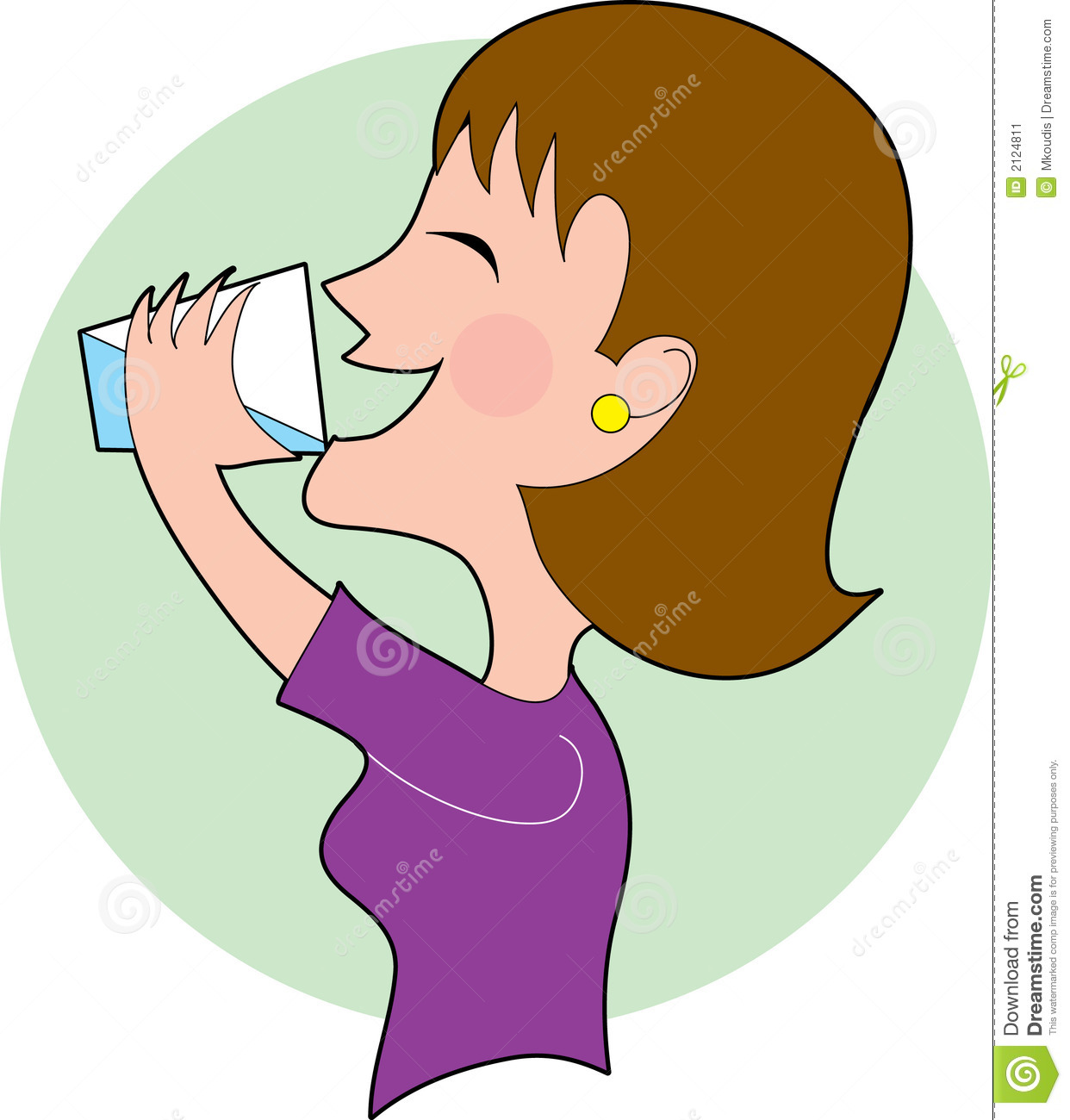 Have your local water treatment plant test [usually free] a sample of your drinking water for chlorine. This will give you information about the amount of chlorine in your drinkable tap water. Public water systems must test their water and file the results with the EPA and your state. You can get a copy of these results by contacting your water provider or state water agency, or at epa: drinking water
Have your local water treatment plant test [usually free] a sample of your drinking water for chlorine. This will give you information about the amount of chlorine in your drinkable tap water. Public water systems must test their water and file the results with the EPA and your state. You can get a copy of these results by contacting your water provider or state water agency, or at epa: drinking water
Chlorine is very unstable and can be removed from tap water in several ways. The simplest way is somewhat labor intensive --- boil the water in a kettle for about 10 minutes to evaporate the chlorine; or leave tape water in a kettle for 24 hours to allow the chlorine gas to escape. In both cases, store the refined water in the refrigerator. To improve taste, pour the cool water back and forth several times to replenish oxygen to the water. [ uncertain about removing chloramine from tap water this way ]
You can buy a carbon block or activated carbon filter and install it on a kitchen faucet [ or your refrigerator ] to automatically remove chlorine from the water. 5 Or you can install a tap water purifier/make clean water system attached to any faucet. You should do your homework about the Consumer Guide to different kinds of water filters available.
Then there may be a related issue of fluoridation that adds fluoride to drinking water. Both fluoride and chlorine are toxic poisons to the human body. Be skeptical in using toothpaste that has fluoride. Read the label on the toothpaste tube to see if it says "do not swallow this toothpaste!" Read more about chlorine and fluoride.
You can: make your own safe drinking water at home.
Finally, you might explore the possibility of using the same chemical that gets rid of chlorine in tap water so the purified water can be used in a fish tank. "It is called sodium hydroximethanosulfate. You can buy it in the pet store, in the section where they keep fish-keeping supplies. A couple of trade names are Amquel and ClorAm-X. One teaspoon removes all chlorine and all ammonia from 10 gallons of water." 28
Restaurant water: Ask for a slice of lemon, then squeeze the juice into the water and stir the water. The vitamin C in the lemon juice will neutralize the chlorine in the water.
Showers:/baths:  Over time, daily exposure to chlorine can cause respiratory illness, asthma, and even certain types of cancer. "Taking long hot showers is a health risk, leads to a greater exposure to toxic chemicals contained in water supplies than does drinking the water. The chemicals evaporate out of the water and are inhaled. They can also spread through the house and be inhaled by others. The chloroform dose from a single, ten minute shower is equal to, and possibly greater than, that from the average two liters of water ingestion on a daily basis. 5 House holders can receive 6 to 100 times more of the chemical by breathing the air around showers and bath than they would by drinking the water." 12
Over time, daily exposure to chlorine can cause respiratory illness, asthma, and even certain types of cancer. "Taking long hot showers is a health risk, leads to a greater exposure to toxic chemicals contained in water supplies than does drinking the water. The chemicals evaporate out of the water and are inhaled. They can also spread through the house and be inhaled by others. The chloroform dose from a single, ten minute shower is equal to, and possibly greater than, that from the average two liters of water ingestion on a daily basis. 5 House holders can receive 6 to 100 times more of the chemical by breathing the air around showers and bath than they would by drinking the water." 12
Install a shower cartridge filter to remove chlorine. Shower filters may use one or a combination of two or more of the following types of shower filter technology: [Shower Filter Comparison] Article in Consumer Guide - Chlorine Shower Filters is no longer active.
Carbon/Charcoal Carbon filters [ also referred to as Granulated Activated Charcoal or GAC ] remove chlorine, chloramines, volatile organic compounds [VOCs] and other synthetic chemicals often used in water disinfection, by the process of carbon adsorption, in which the chemicals stick to activated carbon. These are the most comprehensive shower filters, but since the adsorption process requires a lot of surface area, they are typically larger than other filters. Moreover, carbon filters are typically made for use with cold water [i.e. drinking water] and will not be as effective in a hot shower.
Kinetic Degradation Fluxion (KDF): KDF is an oxidation-reduction media made from copper and zinc. KDF shower filters work electrochemically, converting chlorine into soluble calcium chloride, which is harmless. However, KDF alone will not remove chlorine or VOCs and is often combined with Chlorgon filter technology.
Chlorgon:Chlorgon was specially developed and patented by Sprite Industries, and is only found in Sprite shower filters. It is made to work more efficiently with hot water temperatures, and is therefore an ideal media for shower water filters. Chlorgon is a combination of calcium sulfite with a ceramic binder to form non-soluble ceramic sulfite beads.
Crystalline Quartz Crystalline: Quartz is added to some shower water filters to maximize lathering for a more "energy-enhanced feel."
There are no shower filters on the market that completely remove chloramine; although many web-sites dispute this. There are, however, whole house water filters that remove chlorine, chloramine, and other contaminants. Unfortunately, they’re quite expensive and thus may not be an option for many people. 5
Vitamin C shower filters may be a good choice for those looking for an inexpensive way to reduce the chloramine [and chlorine] content of their showers. Vitamin C is an effective dechlorination agent, removing up to 99% of chlorine and chloramine, and vitamin C filters are much less expensive than the whole house filter mentioned above. The disadvantage to using them is they’re not as durable or effective as a whole house filtration system, and you would need a separate filter for each shower outlet in the house. 5 ALERT: Most vitamin C is synthetically made from GMO corn and synthetic vitamin C is toxic to your body.
Both chlorine and chloramine can be removed for bathing purposes by dissolving Vitamin C in the bath water. One 1000 mg Vitamin C tablet will neutralize chloramine in an average bathtub. 5
Change habits: Other simple methods to reduce exposure to chlorine and chloramine include: taking shorter or less frequent showers, avoiding excessively hot showers [since high heat increases the amount of steam], and shutting the water off while soaping up. These techniques will help decrease your exposure if filtration or dechlorination is not an option. 5
Finally, drink lots of water to flush the toxins out of your body! Eat a whole-complex food diet!
Swimming: 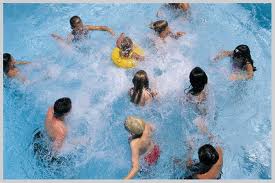 "Maybe chlorine is not the best choice for disinfecting swimming pools."
"Maybe chlorine is not the best choice for disinfecting swimming pools." 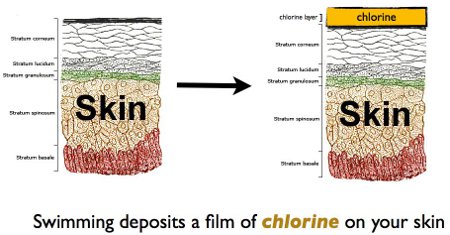 Alternatives do exist. Some pools use ozone, copper and silver ions, or even moss to kill bacteria. 10 Most swimming pools in United States chlorinate their pool water. You can make a difference by switching to oxidation. It is cheaper and safer than chlorination.
Alternatives do exist. Some pools use ozone, copper and silver ions, or even moss to kill bacteria. 10 Most swimming pools in United States chlorinate their pool water. You can make a difference by switching to oxidation. It is cheaper and safer than chlorination.
What swimmers can do: Swimmers can make a difference by simply showering before they get in the pool; they can wash off much of the organic material [ sweat, urine, skin cell, oils, fecal matter ] that reacts with chlorine to produce toxic byproducts. Be aware that swimming is still healthier than not exercising. 10 Swimmers also need to shower immediately after getting out of the pool.
Jaccuzi/sauna: Jaccuzi's use the same tape water you do at home, so it is probably chlorinated. When the water is heated into steam, the same respiratory and skin problems may occur as in a shower and swimming pool.
Organize a movement 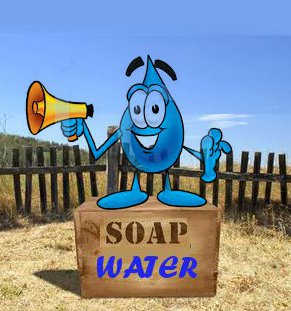 to have your local water treatment plant switch to a non-dangerous system of making your water safe to use: Get a petition circulated and present it to your local government. Seek the advice and help of an expert like Erin Brockovich. 1
to have your local water treatment plant switch to a non-dangerous system of making your water safe to use: Get a petition circulated and present it to your local government. Seek the advice and help of an expert like Erin Brockovich. 1
The cost of using chlorine is unnecessarily high. As of 1996, Andover, Massachusetts’ new ozone treatment costs $83 per million gallons of purified water, only two-thirds as much as the old chlorine treatment process. The town saves $64,000 annually in chemicals costs alone and uses less electricity. 4
In a study of more than 5,000 pregnant women in the Fontana, Walnut Creek and Santa Clara areas of California, researchers from the state health department found that women who drank more than five glasses a day of tap water containing over 75 parts per billion (ppb) of THMs had a 9.5 percent risk of spontaneous abortion, i.e. miscarriage. Women less exposed to the contaminants showed 5.7 percent risk; no comparison was given for women who ingested no THMs. 4
The Water Purification Controversy: There is a great concern and controversy about the different filtration technologies and what these do. Many privately vested shower filtration methods that address chloramines claim that they do NOT work in warm/hot temperatures, NOR in showerheads [since it can take around 30 minutes of contact time to be effective]. In addition to this, there is also controversy about using the vitamin C filter that may be made from synthetic acorbic acid, [ a toxic poison to your body ] made from GMO corn. Another unresolved issue is whether the filter you might use actually removes chloramines and by-product substances. What all this uncertainty tells us is that we lack good, independent and reliable scientific filter information. Why isn't the government spear-heading a search for the truth?
And more importantly, why are many water utilities still using antiquated 1909 water purification systems and not changing to a safer system? [ Doing so would minimize the harmful effects of chlorination ] Providing safe drinking water is a critical and essential part of our infra- structure that supports a society. Without safe drinking water there is NO way to maintain the health of the entire population, and needless to say, sustain the economy of the country. Chlorinating water may kill pathogens but it also destroys our health; it does not make the water safer! Many other countries and even a few purification systems in United States and Canada have switched to oxygen purification systems that are safer and much less expensive. Our leaders need to get their priorities straight! There is no life without safe drinking water.
There is more information about water purification plants: Water menu
But installing a shower water filter at this time would be a prudent way to protect your skin, hair and lungs from long-term exposure to gaseous chlorine by-products.
What local water treatment plants can do to reduce using poisonous chlorine:
Old system:
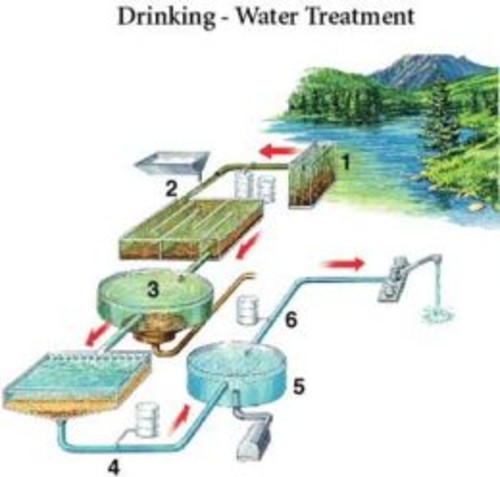 |
| Steps in water filtration to remove unwanted substances in water: 1 First Filtration: Water is filtered through screens that remove fish, leaves & trash. 2 Coagulation: Alum is added to sticky flocs. Mud, bacteria & other particles stick to the flocs. The water then passes into settling basins , where the flocs sink. 3 Second Filtration: The water trickles through sand or gravel, which filters out algae, bacteria, and some chemicals. 4 Chlorination: Chlorine is added to kill remaining organisms 5 Aeration: Forcing air through the water adds oxygen, reducing unpleasant odors and taste. 6 Additional treatment: Sodium may be used to soften hard water or lime to adjust pH. Some communities may add fluoride to prevent tooth decay. Water treatment engineers |
Most water purification systems remove organic materials from the water first before chlorinating it. Diagram on right is an example of how cities may purify the water [ steps 1 to 6 ]. Chlorine is one of the most reactive elements found in nature. It readily dissolves in water, where it combines with molecules of oxygen and hydrogen to form hypochlorous acid and hypochlorite ion. Chlorination of water is achieved by adding chlorine gas directly to the water supply, or by adding the chemicals calcium hypochlorite or sodium chlorite, both of which are known as "free available chlorine".
Substitute Water Treatments:
Hydrogen peroxide (H2O2): "destroys infectious organisms and impurities in water 4,000 times better than 2chlorine. “A 35-percent technical grade H2O2 will promote bacterial growth to break down sewage and enhance the dissolved oxygen level in discharge water entering lakes and streams.”
Ozone (O3) treatment is equally effective. Ozone: "was first used for drinking water treatment in 1893 in the Netherlands. Worldwide, 1,100 cities treat their drinking water with ozone; many have done so since as early as 1901. While being used frequently in Europe for drinking water disinfection and oxidation, it has been slow to transfer to the United States. In 1987, the Los Angeles Aqueduct Filtration Plant was placed in service and now treats up to 600 mgd of drinking water. Rice reported that as of April 1998, 264 water treatment operating plants in the United States used ozone. Most of these facilities are small: 149 plants are below 1 mgd. 2
Los Angeles treats its drinking water with H2O2, and then adds chlorine. Some chlorine may likewise be added after ozonation to prevent re-infestation; about one-third as much suffices. To generate ozone, dry air or oxygen is passed through a high-voltage electrical field. Ozone drinking-water treatment in Andover, Massachusetts successfully controlled the effects of algae blooms and eliminated water quality problems. Potential THM formation was reduced by an average of 75 percent. H2O2 and O3 are relatively inexpensive; moreover, the only byproducts are pure oxygen and hydrogen, so no one can reap a big immediate profit on their disposal. France and Germany, wiser and less controlled by the chemical industry, now chlorinate water only in emergencies." 4
Ultra Violet Light [UVL]: needs direct contact with pathogens, as well as target dosage. Hence UVL application is difficult to achieve in many water purification plants." 2
New NASA Technology: Even for recreational waters [swimming pools, hot tubs, therapy spas, etc.] can be better served by combining small amounts limited amounts of chlorine] with copper-silver ionization treatment methods. This ionization technology was perfected by NASA and the space program over the last 4 decades. And it is recognized around the world as safe, more effective and far more stable than chlorine alone. 27 This is real, scientific and proven technology that can mean better health to everyone and can help save money at the same time. Blog: 5
Copper-silver ionization is a modern implementation of the ancient Greek practice of reducing bacteria in wine vessels by lining them with silver, and controlling algae and fungi with copper. Copper-silver ionization has been effective in swimming pools (it is an alternative to chlorine) and is becoming adopted by larger municipalities.
Since the 1980s, copper-silver ionization has been used in ocean going vessels, luxury yachts, off-shore drilling rigs, swimming pools, breweries, bottlers and many other water systems. This process is used in combination with USEPA approved water purification systems.
Reverse osmosis is another option to chlorination: it can be installed in a large community or a small unit in your home. Home drinking units throw away three gallons while making one gallon of drinkable water.
References:
1 Brockovich Erin, "Protection or Poison? Chloramination of Drinking Water, October 2010. Brockovich: Chloramination 2010
2 Environ Protection Agency, "Alternative Disinfectants and Oxidants Guidance Manual, EPA 815-R-99-014, April 1999. EPA Manual 1999 "Trihalomethanes (THMs) are disinfection byproducts that are formed when organic matter in the water combines with chlorine. •THMs are also formed with chloramine disinfection but at a lower concentration-- (approximately 1/3 less) than chlorine. •THMs are possible but not proven cancer causing byproducts. •To reduce THMs, the Environmental Protection Agency (EPA) offers other disinfection methods such as ultraviolet UV light treatment and chlorine dioxide (see the Alternative Disinfectants and Oxidants Guidance Manual, EPA 815-R-99-014, April 1999; the Table of Contents lists disinfection methods, one per chapter.) No mention of how chlorine poisons humans"
3 Doc's Fitness Tips, "Chlorine Poisoning From Your Tap Water," September 7, 2013. Chlorine poisoning 2013
4 Hattersley Joseph G. "The Negative Health Effects of Chlorine," The Journal of Orthomolecular Medicine, 2000, Vol. 15, 2nd Quarter. Hattersley: bad chlorine effects 2000
5 Kresser Chris, "Is your daily shower making you sick?" Health for the 21st Century. Kresser: Shower sickness
6 Florentin A, Hautemanière A, Hartemann P. Health effects of disinfection by-products in chlorinated swimming pools. Int J Hyg Environ Health. November 2011; 214(6):461-9. doi: 10.1016/j.ijheh.2011.07.012. Epub 2011 Sep 1. Review. "eye and skin irritation in swimmers has been hypothesized to originate from chlorine exposure."
7 Weil Andrew, "Dangers of chlorine." Question & Answer Library, October 2009. Article by Weil: Chlorine dangers is no longer active.
8 Milne Roger, "Technology: London's water off to a clean start . . ." New Scientist, August 03, 1991. Milne: Other water treatment 1991 "design the most advanced water treatment system in the world."
9 Nieuwenhuijsen MJ., Smith R., Golfinopoulos S., Best N., Bennett J., Aggazzotti G., Righi E., Fantuzzi G., Bucchini L., Cordier S., Villanueva C. M., Moreno V., La Vecchia C., Bosetti C., Vartiainen T., Rautiu R., Toledano M., Iszatt N., Grazuleviciene R., Kogevinas M., “Health impacts of long-term exposure to disinfection by-products in drinking water in Europe: HIWATE.” Journal of Water Health. 2009 Jun; Vol. 7(2): 185-207. And, US EPA. “Cloramines Q & A’s.” Office of Water. March 2009. Article by Nieuwenhuijsen: Chlorine health links Europe is no longer active. "There appears to be very good epidemiological evidence for a relationship between chlorination by-products, as measured by trihalomethanes (THMs), in drinking water and bladder cancer, but the evidence for other cancers, including colorectal cancer appears to be inconclusive and inconsistent."
10 Sohn Emily, "Chlorinated Pools May Increase Cancer Risk," Discovery News, September 12, 2010 Article by Sohn: increased cancer risk is no longer active. "In water, chlorine reacts with sweat, urine, skin cells and other organic materials to produce all sorts of chemical byproducts. In animal studies, some of those chemicals have been linked with asthma and bladder cancer."
11 Villanueva Cristina M and Laia Font-Ribera, "Health impact of disinfection by-products in swimming pools," Ann Ist Super Sanità 2012 | Vol. 48, No. 4: 387-396 387 DOI: 10.4415/ANN_12_04_06. Villanueva: swimming pool & health 2012
12 Water Health, "Water Sanitation and the Special Problem for Drinking Water presented by Chlorine," January 25, 2011. Water Health: chlorine water problems 2011 "There is increased evidence for an association between rectal, colon and bladder cancer and the consumption of chlorinated drinking water”, this according to the President’s Council on Environmental Quality.""“Chlorine is the greatest crippler and killer of modern times. While it prevented epidemics of one disease, it was creating another. Two decades ago, after the start of chlorinating our drinking water in 1904, the epidemic of heart trouble, cancer ..."
13 Wigle Donald T., "Position Paper Safe Drinking Water: A Public Health Challenge," Chronic Diseases in Canada, 2000, Volume 19, No.3 - 2000. Article by Wigle: link chlorine cancer is no longer active. Chlorinated water link to cancer: "Chlorine's potent oxidizing power causes it to react with naturally occurring organic material in raw water to produce hundreds of chlorinated organic compounds, referred to generically as chlorination disinfection by-products (CBPs). The report by the Laboratory Center for Disease Control, made public yesterday, is based on an exhaustive review of dozens of studies carried out over recent years in Canada and abroad. epidemiological studies indicate an elevated incidence of bladder cancer among those who have been exposed to chlorinated drinking water for long periods. The USEPA also stated that it believes that the overall evidence from available epidemiologic and toxicologic studies on chlorinated surface water continues to support a hazard concern and a prudent public health protective approach for regulation."
14 Bernard Alfred, Sylviane Carbonnelle, Claire de Burbure, Olivier Michel, Marc Nickmilder, "Chlorinated Pool Attendance, Atopy, and the Risk of Asthma during Childhood," Environ Health Perspect, 2006, Article by Bernard: chlorination & asthma is no longer active. "The pool chlorine hypothesis postulates that the rise in childhood asthma in the developed world could result at least partly from the increasing exposure of children to toxic gases and aerosols contaminating the air of indoor chlorinated pools. To further assess this hypothesis, we explored the relationships between childhood asthma, atopy, and cumulated pool attendance (CPA). These findings further support the hypothesis implicating pool chlorine in the rise of childhood asthma in industrialized countries."
15 Fisk MZ, Steigerwald MD, Smoliga JM, Rundell KW. , "Asthma in swimmers: a review of the current literature," Phys Sportsmed, December 22010; 38(4):28-34. doi: 10.3810/psm.2010.12.1822. Review. Article by Fisk: asthma in swimmers is no longer active. "Long-term and acute exposure to swimming pool disinfectants has been shown to increase asthma risk in swimmers through inducing oxidative stress, which results in inflammation of the pulmonary epithelium and subsequent airway remodeling. Individuals with specific genotypes are more likely to develop asthma when exposed to inhaled irritants."
16 Bove F1, Shim Y, Zeitz P., "Drinking water contaminants and adverse pregnancy outcomes: a review," Environ Health Perspect, February 2002; 110 Suppl 1:61-74. Bove: pregnancy problems 2002 "The studies of THMs and adverse birth outcomes provide moderate evidence for associations with SGA, neural tube defects (NTDs), and spontaneous abortions."
17 Righi Elena and others, "Trihalomethanes, chlorite, chlorate in drinking water and risk of congenital anomalies: A population-based case-control study in Northern Italy," Environmental Research, July 2012, Volume 116, Pages 66–73. Righi: chlorine anomalies Italy 2012
18 Bechtolda Petra, and others, "Trihalomethanes, chlorite, chlorate in drinking water and risk of congenital anomalies: A population-based case-control study in Northern Italy," Environmental Research, July 2012, Volume 116, Pages 66–73. Bechtolda chlorine link birth defects 2012
"The use of chlorine dioxide as a water disinfectant is increasing in many countries. ► The health effects of chlorite and chlorate, its main by-products, are still unknown. ► We found excess risks with exposure to chlorite or chlorate for various congenital anomalies. ► Further investigation on chlorite and chlorate occurrence and on their potential health effects is needed."
19 Price, Joseph M., MD, CORONARIES, CHOLESTERON, CHLORINE, 2002 edition, [Shealey Wellness] maintains that the 20th century epidemic of heart disease and strokes is the result of chlorination of water. One of his greatest arguments is that our increase in life expectancy is largely due to the decrease in deaths among the young, a fact that cannot be disputed. Perhaps the greatest support for Dr. Price’s theory is his experiments with chickens, one of the species most explored in atherosclerosis research, second perhaps only to the rabbit. He compared two groups of 50 each of 3 month old cockerels. All were fed equal amounts of corn and oats with 5% margarine (loaded with transfats!). One half were given chlorinated water to drink and one half had only distilled water. Within 3 weeks the chlorine treated animals became lethargic and disheveled and they grew less healthy with time. At autopsy the chlorine treated chickens had atherosclerosis 95% of the time!! No atherosclerosis was found in the control group! Dr. Price later repeated his experiment with similar results. Price: Chlorine & CVD 2002
20 Dunstan R. Hugh et al, "A Preliminary Investigation of Chlorinated Hydrocarbons and Chronic Fatigue Syndrome," The Medical Journal of Australia, September 18, 1995; 163: 294-297. "Conclusion: recalcitrant otganochlorines may have an aetiological role in CFS." Dunstan Chronic fatigue & chlorine 1995
21 McGregora Neil R., R.Hugh Dunstanb, 1, Mariann Zerbesb, Henry L. Buttc, Timothy K. Robertsb, Iven J. Klineberga, "Preliminary Determination of a Molecular Basis to Chronic Fatigue Syndrome," Biochemical and Molecular Medicine, April, 1996, Volume 57, Issue 2, , Pages 73–80. [Abstract] McGregora: Chronic fatigue 1996
22 Group III Edward, "Toxic Chemical: The Health Dangers of Chlorine," Global Healing Center, May 24, 2013. Group: chlorine dangers 2013" chlorine, which has been linked to serious adverse health effects, including dementia in elderly patients."
23 Siritapetawee J, Pattanasiriwisawa W, Sirithepthawee U. Siritapetawee: Trace element analysis of hairs in patients with dementia. J Synchrotron Radiat. 2010 Mar;17(2):268-72. doi: 10.1107/S0909049509055319. Epub 2010 Jan 16. " This study presents the possible roles of calcium, chlorine, phosphorus and sulfur in the etiology of dementia in elderly patients."
24 Jahangiri L, Pigliacelli S, Kerr AR. Severe and rapid erosion of dental enamel from swimming: a clinical report. J Prosthet Dent.October 2010;106(4):219-23. doi: 10.1016/S0022-3913(11)60126-1. "swimming pool chlorine is associated with tooth enamel erosion? It’s not often mentioned but the New York University College of Dentistry lists it as a prime concern."
25 Israel, "Israel Will End Fluoridation in 2014, Citing Health Concerns," Fan Newsletter, August 8th, 2013. Israel: stops fluoridation 2013"Fluoridation is an outdated, unscientific, failed public health blunder,” says Paul Connett, PhD, FAN Executive Director."
26 Morris R D, A M Audet, I F Angelillo, T C Chalmers, and F Mosteller, "Chlorination, chlorination by-products, and cancer: a meta-analysis," American Journal of Public Health July 1992: Vol. 82, No. 7, pp. 955-963. doi: 10.2105/AJPH.82.7.955. Morris: Chlorination cancer analysis 1992
27 LennTech, "Disinfectants Copper-silver ionization," Water Solutions. LennTech: copper-silver ionization
28 Thomas Justin, "Products That Work - The Best Shower Filter Of 2013," Reactual, March 20, 2013. Blog by Gilman Harriet, January 25, 2014. Thomas: Best Shower Filter 2013
"Vitamin C only goes so far in removing chloramine. It actually leaves you with free ammonia. No thanks. The best solution I found is to use the same substance that we use to protect our aquarium fish from death by tap water. It is called sodium hydroximethanosulfate. You can buy it in the pet store, in the section where they keep fish-keeping supplies. A couple of trade names are Amquel and ClorAm-X. One tsp. removes all chlorine and all ammonia from 10 gallons of water. The byproduct is a small amount of nitrate/nitrite. I knew this works great for the fish in our aquarium, but I was cautious about other applications for it. .... You will have to do your own research and decide if you want to try this. Nowhere do I find official statements saying it’s perfectly safe for people to drink water treated with sodium hydroxymethanosulfate. But the FDA definitely approves the use of this chemical in the water of fish that you are about to feed." Blog by Gilman Harriet Additional ino: removing chlorine for beer
Supportive references:
Bennett Susan, "The Hidden Dangers of Drinking Water," Huffington Post, July 19, 2012. Bennett: Drinking water danger 2012
Brockovich Erin, "Letter to the Mayor of Tulsa [City of broken Arrow ], April 17, 2013. Brockovich Research And Consulting, 5737 Kanan Rd, #592, Agoura Hills, Ca., 01301.
Chlorination: How it works? Chlorine kills bacteria and viruses through a simple chemical reaction. The chlorine solution breaks down into different chemicals, including hypochlorous acid (HOCl) and hypoclorite ion (OCl-). Both of these chemicals kill microorganisms by destroying the enzymes and structures inside the cell. When enzymes come in contact with chlorine, hydrogen atoms in the enzymes are replaced by chlorine atoms. This causes the entire molecule to change shape or fall apart. When enzymes don’t function properly, the cell or bacterium dies. HOCl works faster because it is electrically neutral and is able to enter the negatively charged cell wall, while OCl- is electrically negative and is therefore repelled by the cell wall (like two negative magnets) and can only act on the surface. HOCl can kill microorganisms in several seconds, while OCl- may take up to 30 minutes. The pH of the water determines how much of the chlorine solution breaks into HOCl and how much breaks into OCl-. When the pH is low, more Hydrogen (H+) atoms exist in the water and OCl- can easily be converted to HOCl and the disinfection process is more effective. Ideal pH for chlorination is between 5.5 and 7.5. At a pH of 6, the ratio is 80% HOCl and 20% OCl-, at a pH of 7.5 equal amounts exist of each and at a pH of 8, the ratio is 20% HOCl and 80% OCl-. In Practice Chlorine gas (Cl2) is the lease expensive form of chlorine but is the most dangerous since it is stored in pressurized tanks. Calcium hypochlorite can also be used, but is more expensive. Sodium hypochlorite (NaOCl) is found in household bleach and is the most common form of chlorine used for small-scale/household-level treatment. (be aware that the addition of NaOCl increases the pH.)
City of Broken Arrow, May 10, 2013 Article by Broken Arrow: is no longer active.
Cooney, C.M. “Drinking Water Analysis Turns up Even More Toxic Compounds.” Environmental Science and Technology, 2008, 42(22), p 8175. History of purifying drinking water with alternative to chlorine in Broken Arrow, Oklahoma.
Flynn Dan, "Russia Bans U.S. Poultry Over Chlorine," Food Safety News, January 7, 2010. Flynn: chlorine a food safety
History drinking water: "Historically, drinking water disinfection with chlorine has been extremely successful in addressing bacterial and viral contamination [ since 1908 ]. It has virtually wiped out waterborne diseases like typhoid fever, cholera, and dysentery. However, chlorine disinfection may also cause health risks. When chlorine is added to the water, it not only kills bacteria and viruses, but it also reacts with other chemicals dissolved in the water to form new compounds, known as disinfection byproducts. Some of these byproducts, such as trihalomethanes [THMs], are thought to cause cancer and pose other long-term health risks. Chloramine, on the other hand, is a combination of chlorine and ammonia. While chlorine dissipates and evaporates into the air relatively quickly, chloramine is more stable and will last longer in the water system. The goal is to provide increased protection from bacterial contamination. Chloramine also happens to be the cheapest and easiest of the options available to water utilities. Yet even though the use of chloramine is convenient, it may not be safe. " Brockovich: Chloramination 2010
GaimiaLife, "Does the Chlorine in Tap Water Raise Your Health Risks?" EarthTalk.
Infra-Structure: "The term typically refers to the technical structures that support a society, such as roads, bridges, water supply, sewers, electrical grids, telecommunications, and so forth, and can be defined as "the physical components of interrelated systems providing commodities and services essential to enable, sustain, or enhance societal living conditions." Wiki: Infra-structure
Johnson-Kula Denise and Lillian Lieberman, "Chloramine Facts," Citizens Concerned About Chloramine, 2006. Article by Johnson-Kula Chlorine facts is no longer active.
Murdoch R N, T K Roberts, M Donohoe, J A Watkins, William J.A. TAYLOR, Neil R McGregor, R Hugh Dunstan, " Chlorinated hydrocarbons and chronic fatigue syndrome," Med. J. Aust. 1996. Article by Murdoch s no longer active.
US EPA. “Cloramines Q & A’s.” Office of Water. March 2009. Article by EPA: Cloramines is no longer active.
Villanueva C. M., Cantor, K. P., Grimalt, J. O., Malats, N., Silverman, S., Tardon, A., Garcia-Closas, R., Serra, C., Carrato, A., Castano-Vinyals,G., Marcos, R., Rothman, N., Real, F.X., Dosemeci, M., and Kogevinas, M., "Bladder Cancer and Exposure to Water Disinfection By-Products through Ingestion, Bathing, Showering, and Swimming in Pools," American Journal of Epidemiology. 2007;165:148–156.